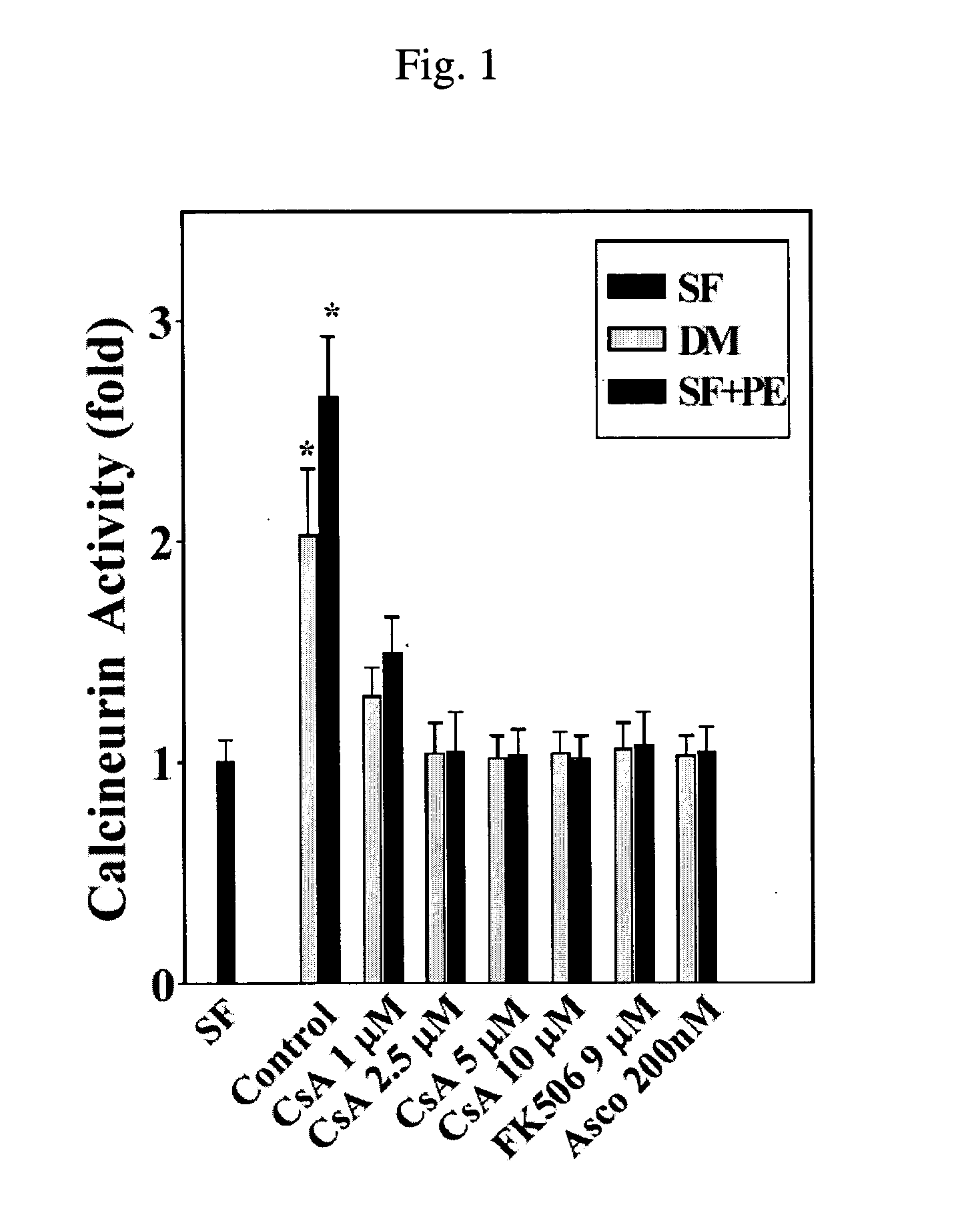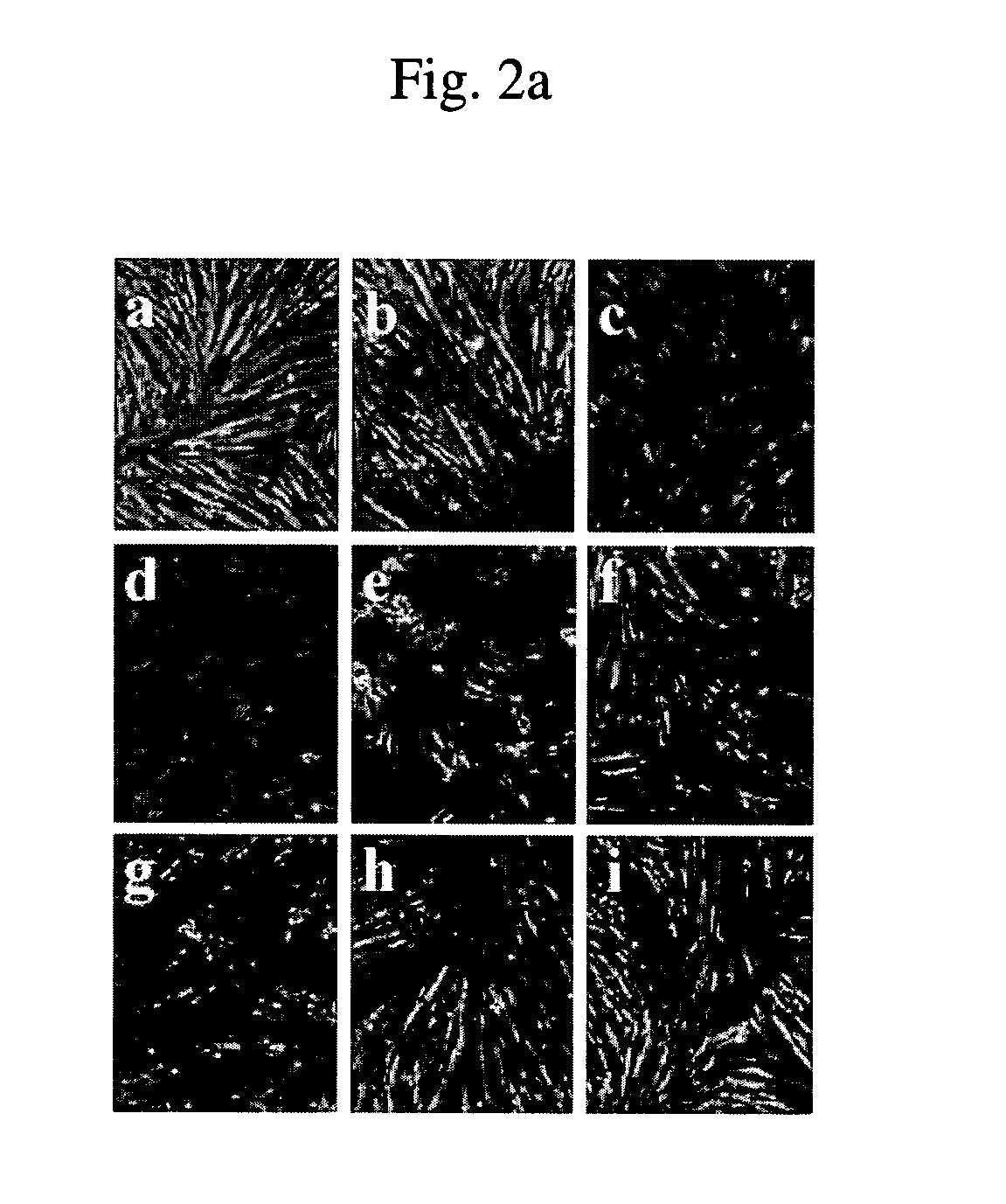Use of cyclophilin as antioxidant and prevention of cyclosporin a-induced toxicity in cell transplantation by overexpression of cyclophilin
a technology of cyclophilin and antioxidant, which is applied in the direction of biocide, peptide/protein ingredients, genetic material ingredients, etc., can solve the problems of preventing cell differentiation blockage, using with great reluctance, and unsuccessful initial clinical trials, and achieves the effect of remarkably reducing the cytotoxicity effect of transplanted cells
- Summary
- Abstract
- Description
- Claims
- Application Information
AI Technical Summary
Benefits of technology
Problems solved by technology
Method used
Image
Examples
example 1
Inhibition of Calcineurin Phosphatase Activity by CsA, FK506 and Ascomycin
[0077] Because CsA inhibits the phosphatase activity of calcineurin that is transiently increased during differentiation, some researchers have suggested that CsA-induced differentiation block might be caused by the inhibition of the phosphatase activity of calcineurin (Abbott, K. L. et al., Mol. Biol. Cell. 9, 2905-2916, 1998; Friday, B. B. et al., J. Cell. Biol. 149, 657-666, 2000). The present inventors examined the effects of immunosuppressants, CsA, FK506 and ascomycin on the calcineurin phosphatase activity.
[0078] First, the concentration of the immunosuppressants at which the calcineurin phosphatase activity could be maximally inhibited was determined. Cardiac myoblasts of H9c2 rats (ATCC, Manassas, Va., USA) were maintained in a DMEM / F-12 medium supplemented with 10% (v / v) donor calf serum and antibiotic mixture (penicillin G, streptomycin and amphotericin B) (Proliferation Medium, PM). Muscle differ...
example 2
Effects of CsA, FK506 and Ascomycin on Muscle Differentiation and Apoptosis
[0083] 2-1. Effect of CsA on Muscle Differentiation of Rat Cardiac Myoblasts
[0084] Effects of CsA, FK506, ascomycin and SDZ NIM811 on the differentiation of H9c2 rat cardiac myoblasts were investigated. SDZ NIM811 is a CsA analogue lacking calcineurin inhibitory activity.
[0085] After being cultured for 72 hours in DM in the respective presence of CsA, FK506, ascomycin and SDZ NIM811, H9c2 rat cardiac myoblasts were observed for morphological changes during muscle differentiation. The results are given in FIG. 2a. As a control, myoblasts were cultured in the absence of the drugs. Before use, the myoblasts were cultured to a cell confluency of about 70%.
[0086] It is apparent from FIG. 2a that while treatment with CsA or SDZ NIM811 blocks the myoblast differentiation with concomitant reduction of cell populations, treatment with FK506 or ascomycin results in no morphological differences in comparison to the ...
example 3
Induction of Apopotosis by CsA through ROS Generation
[0103] 3-1 ROS Generation by CsA and Relation between Antioxidant and ROS Level
[0104] H9c2 myoblasts were cultured for 24 hours in PM and in DM, and then in the presence of 10 μM DCF(2′,7′-dichlorofluorescein). After being harvested, the cells were washed once with PBS and resuspended in 800 ml of PBS. The cellular levels of ROS generated were measured by flow cytometry (FACS), there values were regarded as controls. Next, the PM was converted into DM in which cells were incubated for 24 hours in the presence of 10 μM CsA or 10 μM SDZ NIM811. ROS levels were analyzed by FACS. Separately, 0.4 mM deferoxamine mesylate (DFOM) or 2000 units / ml catalase was added to DM, incubated for 30 min, then, 10 μM CsA was added and the cells were incubated for another 24 hrs. ROS levels were measure as the above. The results are given in FIG. 5a where numerals indicate mean±standard deviation values of the ROS levels in the cells.
[0105] As sho...
PUM
| Property | Measurement | Unit |
|---|---|---|
| pH | aaaaa | aaaaa |
| pharmaceutical composition | aaaaa | aaaaa |
| affinity | aaaaa | aaaaa |
Abstract
Description
Claims
Application Information
 Login to View More
Login to View More - R&D
- Intellectual Property
- Life Sciences
- Materials
- Tech Scout
- Unparalleled Data Quality
- Higher Quality Content
- 60% Fewer Hallucinations
Browse by: Latest US Patents, China's latest patents, Technical Efficacy Thesaurus, Application Domain, Technology Topic, Popular Technical Reports.
© 2025 PatSnap. All rights reserved.Legal|Privacy policy|Modern Slavery Act Transparency Statement|Sitemap|About US| Contact US: help@patsnap.com



